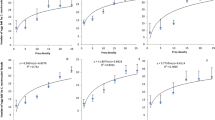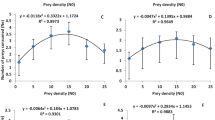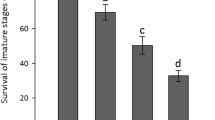Abstract
In the last few years, Dactylopius opuntiae has seriously harmed the cactus pear in Morocco. Chemical control and predators are presently the predominant method used to control this scale pest. In this study the lethal and sublethal effects of the insecticides: d-limonene (60 g/l) 150 cc/hl, mineral oil (780 g/l) 2400 cc/hl, and potassium salts of fatty acid (500 g/l) 40 cc/hl on Cryptolaemus montrouzieri (mealybug destroyer) were evaluated under laboratory conditions at 26±2°C, 60±10 % RH and 12:12 h L:D regime. The results of this study show that potassium salts of fatty acid (500 g/l) 40 cc/hl seems to be less compatible with C. montrouzieri. This chemical insecticide was decreased oviposition period, adult longevity, fecundity, significantly decreased females fertility compared to other treatments, caused a high percentage of mortality for all larval stages and pupa compared to all other treatments tested, caused significant reductions in percentage of egg hatching, and decreased significantly the longevity of adult stage compared to others treatments. Mineral oil (780 g/l) 2400 cc/hl seems to be most compatible with C. montrouzieri. This biological insecticide does not affect significantly the females fertility and does not cause any significant reduction in percentage of egg hatching (100 %) compared to the control treatment. In addition, d-limonene (60 g/l) 150 cc/hl, and mineral oil (78 %) 2400 cc/hl treatments do not affect significantly long term population parameters, including T, rm, λ, and DT compared to control treatment. Thus, both biological insecticides mineral oil (780 g/l) 2400 cc/hl and d-limonene (60 g/l) 150 cc/hl could be used as part of the integrated pest management strategy using C. montrouzieri and more attention should be paid to the use of chemical insecticide potassium salts of fatty acid (500 g/l) 40 cc/hl.

Similar content being viewed by others
References
Agnello A (2002) Petroleum-derived spray oils: chemistry, history, refining and formulation. In: Beattie GAC, Watson DM, Stevens ML, Rae DJ, Spooner-Hart RN (eds) Spray oils beyond 2000. University of Western Sydney, Sydney, pp 2–18
Aldama-Aguilera C, Llanderal-Cázares C (2003) Cochineal: comparison of production methods in cut cladodes. Agrociencia 37:11–19
Anjitha A, Krishnamoorthy SV, Kuttalam S (2013) Toxicity of insecticides to the coccinellid predators, Cryptolaemus montrouzieri Mulsant and Scymnus coccivora Ayyar of papaya mealybug, Paracoccus marginatus Williams and Granara de Willink. J Biol Control 27:18–23
Badii MH, Flores AE (2001) Prickly pear cacti pests and their control in Mexico. Fla Entomol 84:503–505
Bass C, Denholm I, Williamson MS, Nauen R (2015) The global status of insect resistance to neonicotinoid insecticides. Pestic Biochem Physiol 121:78–87
Bouharroud R, Amarraque A, Qessaoui R (2016) First Report of the Opuntia Cochineal Scale Dactylopius Opuntiae (Hemiptera: Dactylopiidae) in Morocco. EPPO Bulletin 46:308–310
Bouharroud R, Sbaghi M, Boujghagh M, El Bouhssini M (2018) Biological control of the prickly pear cochineal Dactylopius opuntiae Cockerell (Hemiptera: Dactylopiidae). EPPO Bulletin 48:300–306
Bouharroud R, El Aalaoui M, Boujghagh M, Hilali L, El Bouhssini M, Sbaghi M (2019) New Record and Predatory Activity of Hyperaspis campestris (Herbst 1783) (Coleoptera: Coccinellidae) on Dactylopius opuntiae (Hemiptera: Dactylopiidae) in Morocco. Entomological News 128(2):156–161
Brennan TCR, Kromer JO, Nielsen LK (2013) Physiological and transcriptional responses of Saccharomyces cerevisiae to d-limonene show changes to the cell wall but not to the plasma membrane. Appl Environ Microbiol 79:3590–3600
Campiche S, Slooten KB, Ridreau C, Tarradellas J (2006) Effects of insect growth regulators on the nontarget soil arthropod Folsomia candida (Collembola). Ecotox Environ Safe 63:216–225
Carver RH, Nash JG (2011) Doing data analysis with SPSS: version 18.0. Cengage Learning (U.S)
Castro AA, Lacerda MC, Zanuncio TV, Ramalho FS, Polanczyk RA, Serrao JE, Zanuncio JC (2012) Effect of the insect growth regulator diflubenzuron on the predator Podisus nigrispinus (Heteroptera: Pentatomidae). Ecotoxicol 21:96–103
Clausen CP (1978) Introduced parasites and predators of arthropod and weeds: a world review. (Ed. Clausen, C. P.), Agriculture Handbook No. 480, USDA Agricultural Research Service, Washington, D. C., 545 pp
Coyne JF, Lott LH (1976) Toxicity of substances in pine oleoresin to southern pine beetles. J Ga Entomol Soc 11:301–305
Davidson NA, Dibble JE, Flint ML, Marner PJ, Guye A (1991) Managing insects and mites with spray oils. Publication 3347. Davis, CA: University of California
Dawar FU, Zuberi A, Azizullah A, Khan Khattak MN (2016) Effects of cypermethrin on survival, morphological and biochemical aspects of rohu (Labeo rohita) during early development. Chemosphere 144:697–705
Dumaniya SG, Patel MB, Siddhapara MR (2015) Toxicity of insecticides to Cryptolaemus montrouzieri (Mulsant). J Cotton Res Dev 29:121–124
El Aalaoui M, Bouharroud R, Sbaghi M, El Bouhssini M, Hilali L, Dari K (2019a) Comparative toxicity of different chemical and biological insecticides against the scale insect Dactylopius opuntiae and their side effects on the predator Cryptolaemus montrouzieri. Arch Phytopathol Plant Prot 52:155–169
El Aalaoui M, Bouharroud R, Sbaghi M, El Bouhssini M, Hilali L (2019b) Predatory potential of eleven native Moroccan adult ladybird species on different stages of Dactylopius opuntiae (Cockerell) (Hemiptera: Dactylopiidae). EPPO Bulletin 49(2):374–379
El Aalaoui M, Bouharroud R, Sbaghi M, El Bouhssini M, Hilali L, Dari K (2019c) First study of the biology of Cryptolaemus montrouzieri and its potential to feed on the mealybug Dactylopius opuntiae (Hemiptera: Dactylopiidae) under laboratory conditions in Morocco. Arch Phytopathol Plant Prot 52:1112–1124
El Aalaoui M, Bouharroud R, Sbaghi M, El Bouhssini M, Hilali L (2020a) Seasonal biology of Dactylopius opuntiae (Hemiptera: Dactylopiidae) on Opuntia ficus-indica (Caryophyllales: Cactaceae) under field and semi field conditions. Ponte 76:259–271. https://doi.org/10.21506/j.ponte.2020.1.17
El Aalaoui M, Sbaghi M, Bouharroud R, El Bouhssini M (2020) Hilali L (2020b) Hyperpredation of local adults ladybirds on the eggs of Cryptolaemus montrouzieri a potential predator of carmine cactus cochineal Dactylopius opuntiae in Morocco. Int J Trop Insect Sci. https://doi.org/10.1007/s42690-020-00282-w
Elzen GW (2001) Lethal and sublethal effects of insecticide residues on Orius insidiosus (Hemiptera: Anthocoridae) and Geocoris punctipes (Hemiptera: Lygaeidae). J Econ Entomol 94:55–59
Fernandez DE, Beers EH, Brunner JF, Doerr M, Dunley JE (2001) Mineral oil inhibition of white apple leafhopper (Homoptera: Cicadellidae) oviposition. J Entomol Sci 36:237–243
Flores A, Olvera H, Rodríguez S, Barranco J (2013) Predation Potential of Chilocorus Cacti (Coleoptera: Coccinellidae) to the Prickly Pear Cacti Pest Dactylopius Opuntiae (Hemiptera: Dactylopiidae). Neotrop Entomol 42:407–11
Galvan TL, Koch RL, Hutchison WD (2005) Effects of spinosad and indoxacarb on survival, development, and reproduction of the multicolored Asian lady beetle (Coleoptera: Coccinellidae). Biol Control 34:108–114
Halappa B, Awaknavar JS, Archana D, Bandi S, Kumar GA (2013) Laboratory evaluation of insecticides against australian beetle, Cryptolaemus montrouzieri Mulsant (Coccinellidae: Coleoptera). Current Biotica 7:196–201
Hannig GT, Ziegler M, Marcon PG (2009) Feeding cessation effects of chlorantraniliprole, a new anthranilic diamide insecticide, in comparison with several insecticides in distinct chemical classes and mode-of-action groups. Pest Mana Sci 65:969–974
Hodek I, van Emden H, Honk A (2012) Ecology and Behaviour of the Ladybird Beetles. Wiley-Blackwell, West Sussex
Hollingsworth RG (2005) Limonene, a citrus extract, for control of mealybugs and scale insects. J Economic Entomol 98:772–779
Juen A, Hogendoorn KMG, Schmidt O, Keller MA (2012) Analysing the diets of invertebrate predators using terminal restriction fragments. J Pest Sci 85:89–100
Karr LL (1989) Toxic properties of d-limonene in insects and the earthworm Eisenia fetida. Dissertations, University of Iowa, Ames, IA (US)
Kavi LA, Kaufman PE, Scott JG (2014) Genetics and mechanisms of imidacloprid resistance in house flies. Pestic Biochem Physiol 109:64–69
Kim M, Shin D, Suh E, Cho K (2004) An assessment of the chronic toxicity of fenpyroximate and pyridaben to Tetranychus urticae using a demographic bioassay. Appl Entomol Zool 39:401–409
Kontodimas DC, Stathas GJ (2005) Phenology, fecundity and life table parameters of the predator Hippodamia variegata reared on Dysaphis crataegi. BioControl 50:223–233
Lanka SK, Ottea JA, Beuzelin JM, Stout MJ (2013) Effects of chlorantraniliprole and thiamethoxam rice seed treatments on egg numbers and first instar survival of Lissorhoptrus oryzophilus (Coleoptera: Curculionidae). J Econ Entomol 106:181–188
Laznik Z, Trdan S (2014) The influence of insecticides on the viability of entomopathogenic nematodes (Rhabditida: Steinernematidae and Heterorhabditidae) under laboratory conditions. Pest Manag Sci 70:784–789
Lu Y, Wu K, Jiang Y, Guo Y, Desneux N (2012) Widespread adoption of Bt cotton and insecticide decrease promotes biocontrol services. Nature 487:362–365
Mani M, Thontadarya TS (1988) Field evaluation of Cryptolaemus montrouzieri Muls. in the suppression of grape mealy bug, Maconellicoccus hirsutus (Green). J Biol Control 2:14–16
Mann J (1969) Cactus-feeding insects and mites. US Natl Mus Bull 256:1–158
Martinou AF, Stavrinides MC (2015) Effects of Sublethal Concentrations of Insecticides on the Functional Response of Two Mirid Generalist Predators. PLoS One 10(12):e0144413
Moore D (1988) Agents used for biological control of mealybugs (Pseudococcidae). Biocontrol News Inf 9:209–225
Moscardini VF, Gontijo PC, Michaud JP, Carvalho GA (2015) Sublethal effects of insecticide seed treatments on two Nearctic lady beetles (Coleoptera: Coccinellidae). Ecotoxicol 24:1152–1161
Murali Baskaran RK, Geetha Lakshmi L, Uthamasamy S (1999) Comparative biology and predatory potential of Australian ladybird beetle (Cryptolaemus montrouzieri) on Planococcus citri and Dactylopius tomentosus. Indian J Agric Sci 69:605–606
Nawaz M, Cai W, Jing Z, Zhou X, Mabubu JI, Hua H (2017) Toxicity and sublethal effects of chlorantraniliprole on the development and fecundity of a non-specific predator, the multicolored Asian lady beetle, Harmonia axyridis (Pallas). Chemosphere 178:496–503
Obrycki JJ, Harwood JD, Kring TJ, O’Neil RJ (2009) Aphidophagy by Coccinellidae: application of biological control in agroecosystems. Biol Control 51:244–254
Osborne LS, Petitt FL (1985) Insecticidal soap and the predatory mite, Phytoseiulus persimilis (Acari: Phytoseiidae), used in management of the two spotted spider mite (Acari: Tetranychidae) on greenhouse grown foliage plants. J Econ Ent 78:687–691
Planes L, Catalán J, Tena A, Porcuna JL, Jacas JA, Izquierdo J, Urbaneja A (2013) Lethal and sublethal effects of spirotetramat on the mealybug destroyer, Cryptolaemus montrouzieri. J pest sci 86:321–327
Protasov A, Mendel Z, Spodek M, Carvalho CJ (2017) Management of the Opuntia cochineal scale insect, Dactylopius opuntiae (Cockerell) in Israel. Alon Hanotea 71:48–51
Puinean AM, Denholm I, Millar NS, Nauen R, Williamson MS (2010) Characterisation of imidacloprid resistance mechanisms in the brown planthopper, Nilaparvata lugens Stal (Hemiptera: Delphacidae). Pestic Biochem Physiol 97:129–132
Rahmani S, Bandani AR (2013) Sublethal concentrations of thiamethoxam adversely affect life table parameters of the aphid predator, Hippodamia variegate (Goeze) (Coleoptera: Coccinellidae). Crop Prot 54:168–175
Riedl H, Halaj J, Kreowski WB, Hilton RJ, Westigard PH (1995) Laboratory evaluation of mineral oils for control of codling moth (Lepidoptera: Tortricidae). J Econ Entomol 88:140–147
Rimoldi F, Schneider MI, Ronco AE (2012) Short and Long-term effects of endosulfan, cypermethrin, spinosad, and methoxyfenozide on adults of Chrysoperla externa (Neuroptera: Chrysopidae). J Econ Entomol 105:1982–1987
Saber M (2011) Acute and population level toxicity of imidacloprid and fenpyrox- imate on an important egg parasitoid, Trichogramma cacoeciae (Hymenoptera: Trichogrammatidae). Ecotoxicol 20:1476–1484
Saddiq B, Shad SA, Aslam M, Ijaz M, Abbas N (2015) Monitoring resistance of Phenacoccus solenopsis Tinsley (Homoptera: pseudococcidae) to new chemical insecticides in Punjab, Pakistan. Crop Prot 74:24–29
Sahito HA, Abro GH, Syed TS, Memon SA, Mal B, Kaleri S (2011) Screening of pesticides against cotton mealybug Phenacoccus solenopsis Tinsley and its natural enemies on cotton crop. Int Res J Biochem Bioinformatics 19:232–236
Sanches NF, Carvalho RS (2010) Procedimentos para manejo da criação e multiplicação do predador exótico Cryptolaemus montrouzieri. Embrapa Mandioca e Fruticultura, Cruz das Almas, p 5
Silva RA, Carvalho GA, Carvalho CF, Reis PR, Pereira AMAR, Cosme LV (2005) Toxicidade de produtos fitossanit_arios utilizados na cultura do cafeeiro a larvas de Chrysoperla externa (Hagen) (Neuroptera: Chrysopidae) e efeitos sobre as fases subseqüentes do desenvolvimento do predador. Neotrop Entomol 34:951–959
Singh SP (1978) Propagation of a coccinellid beetle for the biological control of citrus and coffee mealybugs. Scientific conference. CPA, Dec. 1978, 2 pp
Smith E, Pearce GW (1948) The mode of action of petroleum oils as ovicides. J Econ Entomol 41:173–180
Solangi GS, Lohar MK, Abro GH, Buriro AS (2012) Biology and release of exotic predator Cryptolaemus montrouzieri Mulsant on mealybug Phenacoccus solenopsis Tinsley at Tandojam. Sarhad J Agric 28:429–435
Song Y, Dong J, Sun H (2013) Chlorantraniliprole at sublethal concentrations may reduce the population growth of the Asian corn borer, Ostrinia furnacalis (Lepidoptera: Pyralidae). Acta Entomol Sin 56:446–451
Stara J, Ourednickova J, Kocourek F (2011) Laboratory evaluation of the side effects of insecticides on Aphidius colemani (Hymenoptera:Aphidiidae), Aphidoletes aphidimyza (Diptera: Cecidomyiidae), and Neoseiulus cucumeris (Acari: Phytoseidae). J Pest Sci 84:25–31
Stark JD, Banks JE (2003) Population-level effects of pesticides and other toxicants on arthropods. Annu Rev Entomol 48:505–519
Taylor WE, Vickery B (1974) Insecticidal properties of limonene, a constituent of citrus oil. Ghana J Agric Sci 7:61–62
Tsolakis H, Ragusa S (2008) Effects of a mixture of vegetable and essential oils and fatty acid potassium salts on Tetranychus urticae and Phytoseiulus persimilis. Ecotoxicol Environ Saf 70:276–282
Vanegas-Rico JM, Lomeli-Flores JR, Rodríguez-Leyva E, Mora-Aguilera G, Valdez JM (2010) Natural enemies of Dactylopius opuntiae (Cockerell) on Opuntia ficus-indica (L.) Miller in Central Mexico. Acta Zool Mex (ns) 26:415–433
Vanegas-Rico JM, Lomeli-Flores JR, Rodríguez-Leyva E, Pérez-Panduro A, Hernàndez-González H, Marín-Jar-amillo A (2015) Hyperaspis trifurcata (Coleoptera: Coc-cinellidae) y sus parasitoides en el centro de México. Rev Colombiana de Entomol 41:194–199
Vanegas-Rico JM, Rodríguez-Leyva E, Lomeli-Flores JR, González-Hernández H, Pérez-Panduro A, MoraAguilera G (2016) Biology and life history of Hyperaspis trifurcate feeding on Dactylopius opuntiae. BioControl 61:691–701
Vermeulen JB, Sweet Seugnet, Krause Mareli, Hollings Nora, Nel Annette (1990) A guide to the use pesticides and fungicides in the Republic of South Africa. Government Printer, Pretoria, p 269
Wanumen AC, Sánchez-Ramos I, Viñuela E, Medina P, Adán Á (2016) Impact of feeding on contaminated prey on the life parameters of Nesidiocoris tenuis (Hemiptera: Miridae) adults. J Insect Sci 16:1–7
Wins-Purdya AH, Whitehouse C, Judd GJR, Evenden ML (2009) Effect of horticultural oil on oviposition behaviour and egg survival in the oblique banded leafroller (Lepidoptera: Tortricidae). Can Entomol 141:86–94
Xiao D, Zhao J, Guo X, Chen H, Qu M, Zhai W, Wang S (2016) Sublethal effects of imidacloprid on the predatory seven-spot ladybird beetle Coccinella septempunctata. Ecotoxicol 25:1782–1793
Xu C, Zhang Z, Cui K, Zhao Y, Han J, Liu F, Mu W (2016) Effects of sublethal concentrations of cyantraniliprole on the development, fecundity and nutritional physiology of the black cutworm Agrotis ipsilon (Lepidoptera: Noctuidae). PLoS One 11:0156555
Zwick RW, Westigard PH (1978) Prebloom petroleum oil applications for delaying pear psylla (Homoptera: Psyllidae) oviposition. Can Entomol 110:225–236
Funding
The research of this study was carried out as part of the collaborative program between the National Institute of Agronomic Research (INRA) and the International Center for Agricultural Research in the Dry Areas (ICARDA) in Morocco.
Author information
Authors and Affiliations
Corresponding author
Ethics declarations
Ethical approval
This article does not contain any studies with human participants or animals performed by any of the authors.
Conflict of interest
Author A declares that he has no conflict of interest.
Rights and permissions
About this article
Cite this article
El Aalaoui, M., El Bouhssini, M., Bouharroud, R. et al. Lethal and sublethal effects of the insecticides d-limonene, mineral oil, and potassium salts of fatty acid on Dactylopius Opuntiae potential predator Cryptolaemus Montrouzieri. Int J Trop Insect Sci 41, 2897–2906 (2021). https://doi.org/10.1007/s42690-021-00473-z
Received:
Accepted:
Published:
Issue Date:
DOI: https://doi.org/10.1007/s42690-021-00473-z




